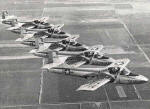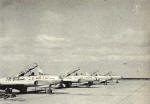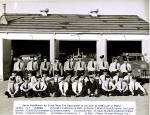|
Perrin Aircraft
 “The only planes we had were BT-13s. Of course, that was February
1942. Everything was BT-13s.” Morris Guzick (1941-1946;
1948-1971) “The only planes we had were BT-13s. Of course, that was February
1942. Everything was BT-13s.” Morris Guzick (1941-1946;
1948-1971)
“The
first accident we had at Perrin Field (of course it was Grayson Basic
Flying School then) was a cadet. He was hedgehopping down Red River.
 On
Red River they used to have a ferryboat crossing, and they had this big
cable crossing the river. We were flying BT-13s. And the BT-13 did not
have retractable landing gear. So as he was hedgehopping, his wheels hit
this cable. . . . It stretched that cable out and then flipped the
airplane back over on its back right in the river. The ferry operator
went out there to see what was going on. The cadet had his mouth up
under the seat. Of course, the seat had a little air pocket, so he got
the canopy open and got the cadet out. He was busted, so I guess he left
probably the next day.” Morris Guzick (1941-1946; 1948-1971) On
Red River they used to have a ferryboat crossing, and they had this big
cable crossing the river. We were flying BT-13s. And the BT-13 did not
have retractable landing gear. So as he was hedgehopping, his wheels hit
this cable. . . . It stretched that cable out and then flipped the
airplane back over on its back right in the river. The ferry operator
went out there to see what was going on. The cadet had his mouth up
under the seat. Of course, the seat had a little air pocket, so he got
the canopy open and got the cadet out. He was busted, so I guess he left
probably the next day.” Morris Guzick (1941-1946; 1948-1971)
“This was
1946. They started using Perrin as a storage base. They brought in
AT-11s and AT-11s were the bombardier trainer. It’s a twin-engine
airplane. They started bringing in B-25s and these AT-11s, and, well,
nobody at Perrin Field had any experience with those airplanes.”
Morris Guzick (1941-1946; 1948-1971)

AT-11 |

B-25 |
“When I first got there, they had what they called the ‘Texan.’ It
was an AT-6, Advanced Trainer 6. North American. They were two-seated
trainers, and that’s what we did. We trained pilots, fresh out of
college or high school or whatever the education they had to get to be a
pilot. They learned to fly out here. They learned to navigate.” Bob
Jennings (1948-1951)
 [When they
re-opened the base in 1948] they were going to fly T-6s. That was just
like duck soup, fly that little old airplane. We could rebuild a T-6,
and believe it or not, we were the only base world-wide, the only United
States base that was flying T-6s that had 100% aircraft in commission.”
Morris Guzick (1941-1946; 1948-1971). [When they
re-opened the base in 1948] they were going to fly T-6s. That was just
like duck soup, fly that little old airplane. We could rebuild a T-6,
and believe it or not, we were the only base world-wide, the only United
States base that was flying T-6s that had 100% aircraft in commission.”
Morris Guzick (1941-1946; 1948-1971).
 “On
occasion, too, gliders they used back in World War II when they invaded
France landed here.” Morris Guzick (1941-1946; 1948-1971). “On
occasion, too, gliders they used back in World War II when they invaded
France landed here.” Morris Guzick (1941-1946; 1948-1971).
“Things were pretty easy, and then they started bringing in some
AT-28s. That was a Northrop trainer that sounded like a tractor. We had
those a while. Then they started bringing some B-26s in.” Morris
Guzick (1941-1946; 1948-1971).
“I had a friend who worked in manpower at base headquarters when the
jets were coming to Perrin. They had a wire they were carrying around.
Big secret. Jets coming to Perrin. Got home, picked up the Sherman
Democrat, and the headlines said, ‘Jets Coming to Perrin.’ Big secret!”
Overton E. Jay (1951-1971).
 “When I got here they had B-26s and T-28s. Then the F-86Ds started
coming and the T-33s. And we kept those until I guess about 1960 they
started bringing the F-102s. They had 104s out here, in and out. They
had B-58s come in later, used to come in and refuel or something like
that.” Ken Hayes (1953-1971) “When I got here they had B-26s and T-28s. Then the F-86Ds started
coming and the T-33s. And we kept those until I guess about 1960 they
started bringing the F-102s. They had 104s out here, in and out. They
had B-58s come in later, used to come in and refuel or something like
that.” Ken Hayes (1953-1971)
 “The Air
Force had a squadron in here that was from Randolph AFB with those
little trainers. We did maintenance on those things, that squadron of
T-37 training planes. I think they were basic trainers.” Morris
Guzick (1941-1946; 1948-1971). “The Air
Force had a squadron in here that was from Randolph AFB with those
little trainers. We did maintenance on those things, that squadron of
T-37 training planes. I think they were basic trainers.” Morris
Guzick (1941-1946; 1948-1971).
 “There
were three flights down in the T-Bird section. The flight ramp was a
concrete ramp; they call that the flight line, and this is where the
planes were parked. There were three groups or flights. The flight
line, the T-Bird end, was good duty. The T-33s were trainer aircraft but
they were also target aircraft for F-102 pilot training.” Ralph
Waterloo (1963-1966) “There
were three flights down in the T-Bird section. The flight ramp was a
concrete ramp; they call that the flight line, and this is where the
planes were parked. There were three groups or flights. The flight
line, the T-Bird end, was good duty. The T-33s were trainer aircraft but
they were also target aircraft for F-102 pilot training.” Ralph
Waterloo (1963-1966)
 “We
had helicopters. And the helicopter was an emergency helicopter. It
carried a fire bottle on it, about a thousand pounds of foam with some
guys that wore suites, and if we had a crash, that helicopter was maybe
in the air hovering around waiting.” James McCall (1951,
1956-1971). “We
had helicopters. And the helicopter was an emergency helicopter. It
carried a fire bottle on it, about a thousand pounds of foam with some
guys that wore suites, and if we had a crash, that helicopter was maybe
in the air hovering around waiting.” James McCall (1951,
1956-1971).
“It was very common, very common, to have a crash. And very common to
have some guy off somewhere call and say, ‘This airplane is out here in
my pasture burning.’ We had a big map of the area with grids on there,
and our job was to locate where that guy was calling from, where that
plane was. . . . Then, if the plane had crashed off base, we formed what
we called convoy, led by our base operations vehicle, which had radios
and so forth in it, to go out to the site, taking the fire department,
you know, as quick as we could.” James McCall (1951, 1956-1971).
 “[We
had] lots fatalities. I went to work our there one time as an aircraft
dispatcher at about 4:00 or 5:00 and before 10:00 or 11:00, we had five
major accidents, killed two or three guys. It was dangerous. That
training was dangerous. Now, if we have an airplane crash, as you know,
in training, we practically have a congressional investigation. “[We
had] lots fatalities. I went to work our there one time as an aircraft
dispatcher at about 4:00 or 5:00 and before 10:00 or 11:00, we had five
major accidents, killed two or three guys. It was dangerous. That
training was dangerous. Now, if we have an airplane crash, as you know,
in training, we practically have a congressional investigation. 
We
didn’t do that then. We were training pilots for air defense command. .
. . They were loaded with rockets. Sometimes they’d crash out there, and
they had a load of rockets on them.” James McCall (1951,
1956-1971).
 Edwin
A. Link provided a giant step forward when in 1931 he received a patent
on his “pilot maker” training device. Organ bellows and a motor
provided the means for the trainer, mounted on a pedestal, to pitch,
roll, dive and climb as the student “flew” it. Ironically, most of his
first sales were to amusement parks. In 1934, the Army Air Corps bought
Link trainers to train pilots to fly at night and in bad weather relying
on instruments. In the World War II era, virtually all aviation cadets
took blind-flying instruction in the Link. Movement of the trainer was
accomplished by vacuum operated bellows, controlled by valves connected
to the control wheel (or stick) and rudder pedals. An instructor sat at
the desk and transmitted radio messages which the student in the Link
heard through his earphones. Inside the “cockpit,” the student relied
on his instruments to “fly” the Link through various maneuvers while his
navigational “course” was traced on a map on the desk by the
three-wheeled “crab.” Slip stream simulators gave the controls the
feeling of air passing over control surfaces and a rough air generator
added additional realism during the “flight.” Edwin
A. Link provided a giant step forward when in 1931 he received a patent
on his “pilot maker” training device. Organ bellows and a motor
provided the means for the trainer, mounted on a pedestal, to pitch,
roll, dive and climb as the student “flew” it. Ironically, most of his
first sales were to amusement parks. In 1934, the Army Air Corps bought
Link trainers to train pilots to fly at night and in bad weather relying
on instruments. In the World War II era, virtually all aviation cadets
took blind-flying instruction in the Link. Movement of the trainer was
accomplished by vacuum operated bellows, controlled by valves connected
to the control wheel (or stick) and rudder pedals. An instructor sat at
the desk and transmitted radio messages which the student in the Link
heard through his earphones. Inside the “cockpit,” the student relied
on his instruments to “fly” the Link through various maneuvers while his
navigational “course” was traced on a map on the desk by the
three-wheeled “crab.” Slip stream simulators gave the controls the
feeling of air passing over control surfaces and a rough air generator
added additional realism during the “flight.”
 “This
one guy I was rooming with was assigned to the link trainer-type
maintenance crews. Our squadron also took care of the trainers. Since
he operated the Link trainers for the pilots, after the pilots were
gone, sometimes we’d go down to the simulator building and get in the
trainer, and we could fly the plane. They could do all kinds of stuff
with the controls. They could even lower the runway out from under
you. We spent a lot of time down there.” George Kerns
(1957-1960) “This
one guy I was rooming with was assigned to the link trainer-type
maintenance crews. Our squadron also took care of the trainers. Since
he operated the Link trainers for the pilots, after the pilots were
gone, sometimes we’d go down to the simulator building and get in the
trainer, and we could fly the plane. They could do all kinds of stuff
with the controls. They could even lower the runway out from under
you. We spent a lot of time down there.” George Kerns
(1957-1960)
Base Life  |
